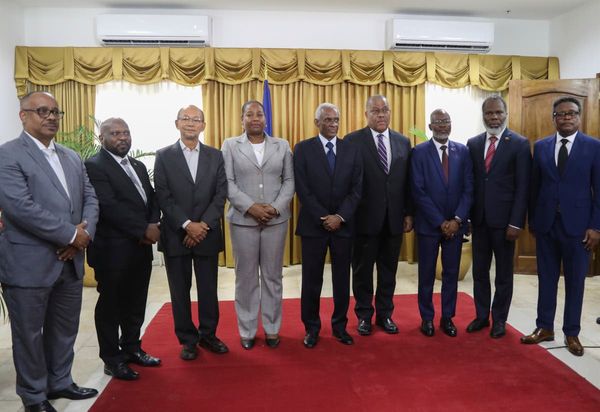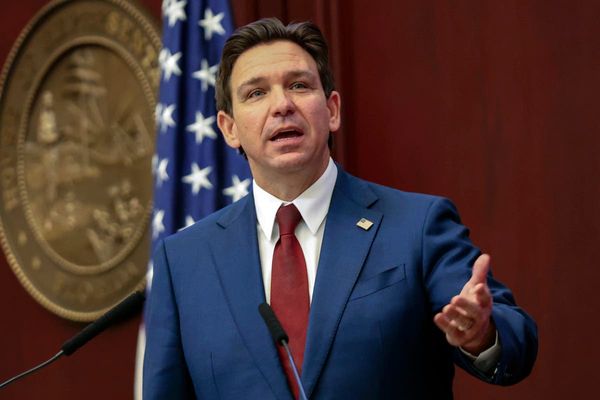In Roger Federer's own words, Peter Carter is the most influential figure in his tennis career.
The Swiss champion rarely speaks of his childhood coach and when he does, he is almost always moved to tears in characteristic Federer fashion.
A touring pro whose life led him to Switzerland and coaching, Carter taught Federer the game in two stints from ages 10 to 14, and 16 to 19.
The man who moulded Federer's game tragically passed away aged 37 while honeymooning in South Africa in 2002.
His untimely passing cruelly came before the player he predicted would one day be "the best player this game has ever seen" won the first of his 20 grand slam titles.
Carter was an Australian, from Nuriootpa in the Barossa Valley region of South Australia.
'He was a very talented kid'
Carter took up the game early in life, learning from his father Bob on the courts of Nuriootpa.
However, his game quickly outsized the small country town and a move to Adelaide beckoned as travel became burdensome.
In the late 1970s, Peter Smith was the South Australian junior state team coach, charged with scouting any players across the state with talent and promise.
"I'd heard about this kid from Nuriootpa, so he was one of the first players I got down," Smith said.
"Carts was a shy country kid who didn't know what it meant to be full of himself or think he was better than he was or whatever.
"Just a really lovely, pleasant young boy. They were my initial memories. In addition to that, when I saw first him play, he was a very talented kid."
The Smith family even ended up billeting Carter, with Peter's wife Bronwyn and three boys Brett, Luke and Joshua welcoming him into the family.
"You're going to find out pretty quickly, when you live with somebody, what sort of person they are," Smith said.
"I can say in total honesty, Peter was an absolute top-shelf kid from the second he got to our place until, I don't think he ever left in a sense, because anytime he was back in South Australia and back in Adelaide in particular, he was obviously always welcome to come back again.
"He was just completely, totally well-mannered, respectful and an absolute pleasure to have in the house."
On the court, Smith was as pleased with Carter as he was at home.
He was clearly the stand-out junior in South Australia amongst a strong field of recognisable names.
In the year beneath Carter was future touring pro Darren Cahill — who would later become his closest friend — and future Melbourne Demons AFL captain Todd Viney, who played up a year, as well as Gavin Pfitzner, Richard Fricker and Anthony Lane.
Cahill took up tennis late at age 13 from an Australian Rules Football background – where his father, John Cahill, is a Port Adelaide legend and Australian Football Hall of Famer.
Cahill remembered being in awe of Carter's game.
"I never beat him in the juniors. I'm not sure about the other boys. He was the by far and away the best player here in South Australia for his age," Cahill said.
Carter and Cahill would both receive an invitation to the Australian Institute of Sport, where their friendship blossomed.
It came right at the time Carter's game was beginning to take off.
In 1982, Carter defeated John Alexander at his hometown event in Adelaide. Alexander had already achieved a career-high ranking of eighth in the world and had just come off a tournament win in Sydney.
Carter's single-handed cross-court backhand on match point was eerily similar to what we would see from his protégé in years to come.
The scenes in the crowd were wild as South Australians – including many of Carter's schoolmates — packed Memorial Drive and waved their shirts above their head as one of their own defeated Alexander.
With his blond bowl cut, youthful appearance and shy country demeanour, Carter was not exactly the most verbose post-match, dealing in one-sentence answers during the on-court interview.
Cahill's early memories of Carter stretched far beyond the court.
"I know my mum loved him," Cahill said.
"My dad, as you know, was heavily involved in football. He always used to talk about the fact that as a youngster you put good people around you and you become the sum average of your friends, and he was absolutely ecstatic that 'Carts' was one of my mates because he had all the world for him."
'He had a beautiful feel for the game'
Carter's playing career peaked at a ranking of 173 in the singles, and 117 in the doubles.
It's a cliché in sport that a career was cruelled by injuries, but it's one Cahill and Smith believe in Carter's case.
"He would have been a top 50 player easily in singles if it wasn't for the injuries that he got," said Cahill, who would go on to coach world number ones Andre Agassi, Lleyton Hewitt and Simona Halep.
"He had a beautiful feel for the game. He knew how to put the ball into difficult positions for opponents.
"He lacked a little bit of power and maybe a little bit of speed, but I think he was growing into his body as he got a bit older as well, so he was going to be a late developer. He just got these injuries that kept on setting him back."
Smith agreed: "Peter could seriously play and it was only his lack of physical size and strength caused most of the troubles plus the injuries."
Carter's injuries ranged from a perforated eardrum in a skiing accident, to a stress fracture in his wrist, and persistent back issues.
Still trying to make it on the tour, he based himself in Europe and took up coaching to try to fund his playing endeavours, working three months of the year as a coach in an attempt to save enough money for the remaining nine as he travelled and played around the world.
It was there at the Tennis Club Old Boys in Basel where Carter would fortuitously come across a prodigious young talent with a slight attitude issue.
According to Smith, it began to dawn on Carter that his success and earning potential as a coach was overtaking his playing.
Given his affinity for Carter the person, Smith would often call and check that he was making his way in the world over in Switzerland.
"I quite clearly remember him mentioning this kid that he coached that just happened to be about the same age as Lleyton Hewitt," Smith, who was working with a young Hewitt back in South Australia, said.
"That's what I remember the most and saying that he thought that Roger had these unique skills and beautiful smoothness, those things were evident even at that age."
On a trip to Europe, Cahill made time to catch up with his old mate and remembers Carter's eagerness to show him his young charge.
"I went out there and he was hitting with him," Cahill said.
"The kid was good, but his backhand wasn't great, he didn't move good, he had a bit of a bad attitude, he was bouncing his racquet during the training session.
"He comes off the court and Carts goes 'what'd you think of him?' and I said, 'well he's alright. He's not bad. You could drive a truck through the backhand'.
"You know that's going to be a problem when he gets a bit older and the kid looks like he's got a bit of a bad attitude, but nah I've got a better kid back in Adelaide who would crunch this kid … Lleyton Hewitt, and I've just started hitting with him and he's a gun.'"
Three years later the best-friends-come-coaching-rivals would get a chance to measure their players against one another when Australia met Switzerland in the junior Davis Cup.
Cahill serving as the Australian team captain and Carter there with the Swiss team, with the Australian forced to bite his tongue as a 15-year-old Federer defeated Hewitt 7-6 in the third set in what he remembers as "incredible tennis".
"We came off the court afterwards and both of us looked at each other and went 'oh my God, these guys are going to play against each other time and time again','" Cahill said.
Carter proved to be a seer, having told Smith's eldest son, Brett, during a trip to Switzerland just how good Federer could be.
"Just sitting down casually talking, not with Roger present," Smith said.
"Bretty said he made this statement — 'this guy will be the best player this game has ever seen'."
'He just made the really difficult look easy'
Anyone who has seen both Carter and Federer on-court will tell you Federer's beautiful all-court game was created in the image of his coach.
Carter, like Federer, played a glorious single-handed backhand – as seen on match point in that 1982 match against Alexander — and he glided around the court with similar style.
"Well actually it was really similar," Cahill said of their games.
"The way he played tennis was that type of style that Federer has. He just made the really difficult look easy and as a junior he sort of floated around the court with grace and easy power and beautiful serve-volley game."
Smith, who taught Carter the single-handed backhand and all-court game, agreed there were similarities.
"I think a really strong similarity … everyone who talks to me about him even these days describes what a pretty player he was and what a beautiful boy he was," he said.
An emotional teen, Federer was trying to manage that alongside his desire for tennis perfection. He would often throw racquets and have outbursts.
"In his own quiet way (Carter) was a tough kid, and my mail was that's how he ran his coaching, and slowly but surely put pressure on Roger to make sure that he followed the good etiquettes of tennis rather than the bad ones," Smith said.
Carter would end up working with former Swedish world number 25 Peter Lundgren at the Swiss National Training Centre, with the pair sharing responsibilities for Federer in his late teens.
The Swede later became Federer's first coach on the tour and guided him to his maiden grand slam title. He would also be with Federer on the fateful night of Carter's tragic passing.
Carter and Lundgren formed a strong bond and working relationship that helped them manage the outbursts of their teen star.
"I could just take an example. Peter Carter and Roger were playing squash at one tournament, and I was there watching," Lundgren said.
"Roger was throwing racquets, he was going wild on the squash court. Peter just left. He just left the court. We always had to kind of do that stuff to make him understand you can't carry on doing this."
'It shook me. It woke me up'
Carter was honeymooning with his wife, Sylvia, in South Africa when the car he was a passenger in flipped, killing both he and the driver.
It was August 1, 2002, and aged just 37, Carter passed away while Federer was still trying to find his way on tour.
"Horrible," Lundgren said.
"We were in Toronto, me and Roger, and so was Darren (Cahill). Darren was coaching Agassi at the time.
"I got a message on my phone that Darren wrote — 'please call me'. So I thought it was about practice, Agassi and Federer, and then I call him and he told me the story what happened in South Africa.
"I was devastated to be honest. I was completely smashed for a week and so was Roger."
However, a clearly gifted, yet young and immature Federer, seemed to blossom out of the tragedy of Carter's passing.
"It shook me. It woke me up. Made me realise how fortunate I am to be a tennis player and how much he would want me not to waste anything," Federer said in a 2014 interview with rival Andy Roddick.
"I think this is when my career maybe went into overdrive. I was like 'OK, I want to make Peter proud even though he's not with us anymore'."
Lundgren, who was on the tour day-to-day with Roger as his coach at the time, agreed with that sentiment.
"Roger grew up after that for sure. He was much more mature. He didn't take everything for granted," Lundgren said.
After the passing of the man who taught him the game, Federer quietly set about honouring the memory of Carter in his own way.
He invited Carter's parents, Bob and Diane, to the Australian Open every year. It is something he has continued throughout his annual visits to Melbourne, flying them over, accrediting and accommodating them.
They would be his guests for the fortnight of the year's first grand slam.
Cahill recalled an encounter with Carter's father at Melbourne Park.
"I walk up and I look to my right and I saw Bob standing next to me, we were standing at the urinal and I went 'Bob, what in the hell are you doing here?' and he looks at me with a big smile on his face and goes 'well I got invited to be over here'," Cahill said.
"I said 'really? Who invited you to come over?' and he goes 'well, Roger Federer'
"And honestly you could have heard a pin drop. The bathroom was packed. You could have heard a pin drop in the bathroom. All these heads turned to look at me and Bob."
Roger Federer may have been surpassed by his two chief rivals, Rafael Nadal and Novak Djokovic, in grand slam titles, but his 310 weeks at world number one, including 237 straight, will not soon be forgotten.
Even more so than that, the style and grace he exhibited both on and off the court will be his lasting legacy and gift to tennis — and the man who taught him how to do both should not be forgotten either.







